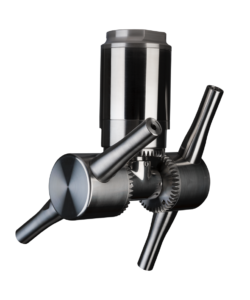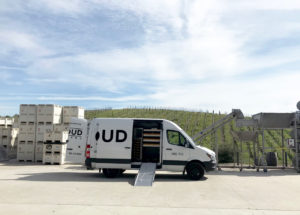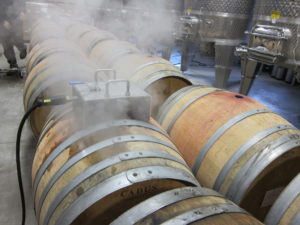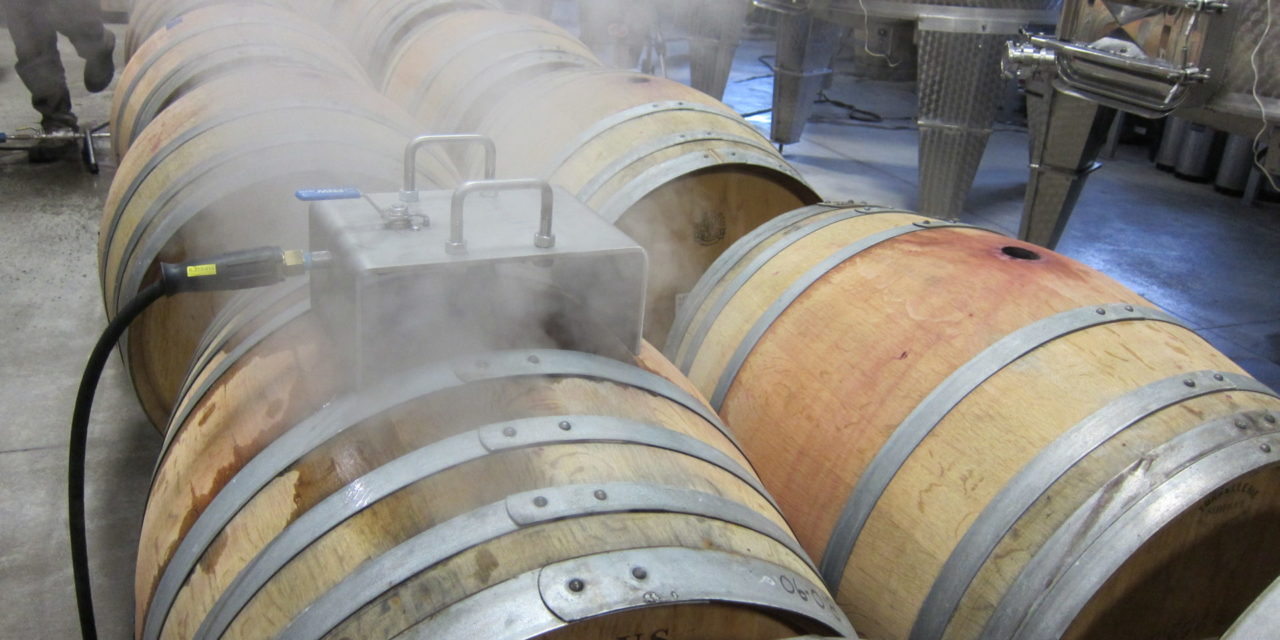Alex Frost remembers cleaning winery tanks and equipment in the old days—and it wasn’t much fun.

Alex Frost, assistant winemaker at Sextant Wines
“No one wanted to be the person who was in the open door of the tank with a scrub pad in hand,” says Frost, assistant winemaker at Sextant Wines in Paso Robles, Calif., “or to be the one with the razor blade who had to go in and scrape away the tartaric acid.”
Much has changed in the world of winery, brewery, and distillery maintenance since then. Yes, improved technology has made it easier to keep tanks, equipment, and premises clean and safe. But new technology, say vendors, manufacturers, and producers, is only part of the equation. These days, producers are smarter about cleaning and understand the need to be more efficient and to cut costs. That means knowing the importance of education, keeping up with the latest developments, and maintaining strict cleaning protocols. This, they say, is true whether using more traditional methods, such as peracetic acid or ozonated water to sanitize equipment, or opting for more high-tech methods, such as high-pressure steam to clean barrels and tanks.

“I can’t tell you how much more important that is, the idea of food-grade standards. That’s why our protocols have to be more complete and more thorough than ever before.” —Rob Klbecka, Robert James Wines
In addition, as federal and state regulation moves toward imposing food-grade safety standards on wineries, breweries, and distilleries, it becomes even more important to understand what you do, why you do it, and how you do it. “I can’t tell you how much more important that is, the idea of food-grade standards,” says Rob Klbecka, proprietor and winemaker at Robert James Wines in Healdsburg, Calif. “That’s why our protocols have to be more complete and more thorough than ever before.”
In the old days
Talk to anyone who’s been in alcohol production for any length of time, and the change in approach to maintenance and cleaning has been little short of astounding. As late as the 1990s, it wasn’t unusual to see a dirty facility or to hear employees say it “wasn’t quite dirty enough” to clean yet.
Not anymore.
“I don’t see a whole lot has necessarily advanced with the available chemical technology, but the approach has certainly changed in the 15 years I’ve been doing this,” says John Rehm, director of brewing operations for Two Roads Brewing in Stratford, Conn. “These days, everyone understands you’re not supposed to flush your cleaning chemicals down the drain.”

“I don’t see a whole lot has necessarily advanced with the available chemical technology, but the approach has certainly changed in the 15 years I’ve been doing this.” —John Rehm, Two Roads Brewing
Believe it or not, that wasn’t always a no-brainer. Hence more education, upgraded standards, and tighter cleaning protocols. Those changes dovetail with state and federal regulators moving to food-grade health standards for wineries, breweries, and distilleries. This is especially true in California, says Frost, where the state often sets the federal agenda because of its tighter standards.
The key here is the federal Food and Drug Administration’s Food Safety Modernization Act (FSMA), which requires most food facilities to have a food safety plan that analyzes and identifies potential hazards and describes risk-based controls to minimize or prevent them. FSMA specifically defines alcoholic beverages as food—bringing breweries, wineries, cider producers and distilleries under direct FDA regulation for the first time (though without affecting TTB authority for labels, marketing, and other three-tier regulation).
“One of the things I always tell new and small craft brewers is that they need to find a supplier who will help them, who will work with them on education, and who will answer their questions,” says Rehm. “It’s all so different than it used to be.”

[Photo courtesy Cloud-Sellers]
Not surprisingly, FSMA is complicated and far-reaching, an undertaking designed to protect the U.S. food supply chain in the 21st century. Its provisions include regulations for foreign producers that sell products in the United States, distinguishes between various classes and sizes of producers, and has taken almost a decade to be implemented. And that’s just the beginning.
Most alcohol producers, for example, are exempt from the food safety plan requirement, but are required to comply with FSMA’s education and training provisions. On the other hand, alcohol beverage producers do need to ensure their employees meet the “competency requirements” outlined in the law. In other words, workers need to be qualified, according to FSMA standards, to do their jobs. This usually means lots of documentation to show job training, as well as education about the principles of food safety (including personal and facility hygiene).

“The van lets us demonstrate our tank cleaning machines and pumps where it matters most: on our customers’ tanks.” —Jason Wiseman, Cloud-Sellers
FSMA is a stricter standard than anything previously in U.S. history, and alcohol beverage producers need to make sure they’re on the right side of the law.
“We don’t regularly encounter FSMA compliance-related questions, but we have hundreds of customers in the wine and brewing industries,” says Jason Wiseman, senior marketing director at cleaning equipment vendor Cloud-Sellers Tank Cleaning Equipment in San Luis Obispo, Calif. In this, vendors know the trust their customers place in them, and they understand the role vendors play in helping customers. It’s not just sell and forget.
Cloud, for example, offers maintenance training and product demonstrations to its customers via a new mobile service and demonstration Sprinter Van. Says Wiseman, “The van lets us demonstrate our tank cleaning machines and pumps where it matters most: on our customers’ tanks. We’re also able to educate maintenance staffs on how to keep their machines running smoothly and efficiently.
“The van is a significant value add for our customers.”
Saving money in the long run
Perhaps the biggest change isn’t advancing technology, but how to better use existing technology.
“Cleaning itself hasn’t changed all that much,” says Michael Coleman, sales and marketing manager for industrial cleaning equipment vendor Hotsy Pacific, with three locations in Northern California. “But today, our customers are trying to become more efficient—trying to reduce water use and be more efficient with the water they do use.”

[Photo courtesy Hotsy Pacific]
Says Coleman, “That’s why steam keeps coming into the equation more and more. It not only does what it’s supposed to do—kill bacteria—but it’s actually much more water efficient, ecofriendly because it kills bacteria without adding chemicals, and it hydrates barrels.” Run a steam system that maintains the desired temperature inside your tanks and barrels, and you’ll get the same result every time. What better way to make sure you’re FSMA compliant?
Vendors say producers often need a convincing reason to make the change to steam or other upgraded cleaning equipment. The reality is, as drought and other water shortages become more common, water will become more expensive. Regardless of where a producer is located, making the change will increasingly make dollars and sense.
It’s also important to use labor more efficiently, adds Coleman, given rising labor costs. Mechanizing the cleaning process, even with spending more money up front, pays off in the long run with fewer employee hours needed to do the job. “Steam systems virtually eliminate the need to enter a tank at all for sanitation,” says Coleman. Mechanization also eliminates the need to assign people to clean tanks and barrels—dirty, difficult, and undesirable jobs—and it’s a lot less aggravating than scraping the inside of a barrel.











